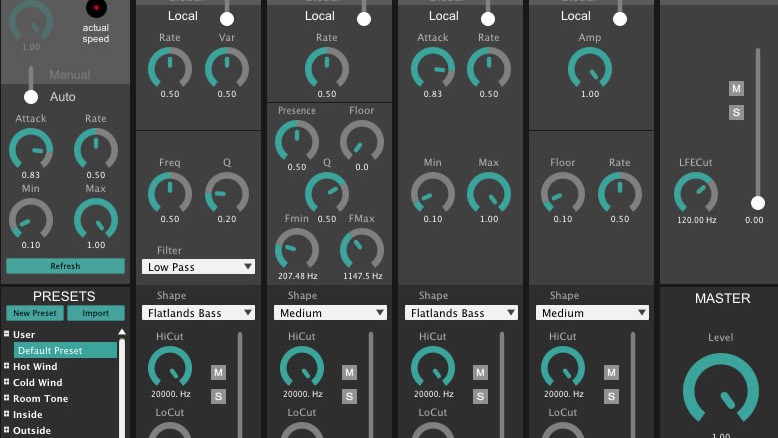Andy Farnell defined in 2007 that procedural audio is “sound qua process, as opposed to sound qua product.” He also simplified the definition in modern terms by saying that procedural audio is “…often synthetic sound, created in real time according to a set of programmatic rules and live input.” When streaming sound from a CD or DVD, the data is of a fixed order and the procession from one value to the next one is automatic. This is where synthesis and procedural audio may have an advantage over this linear audio, as it is possible to apply further inputs to start up new sounds or change existing ones; this also lends great momentum to the creation of non-repetitive and dynamic sounds as discussed in the previous post. Veneri, Gros and Natkin speak further of the benefits of procedural audio content, saying such benefits may include better variety, interactivity, cost and saving on storage. They also warn that procedural audio should not be considered as the superior method of generating audio content because of certain drawbacks including high computational costs and sometimes unpredictable behaviours.
In relation to video gaming, procedural audio techniques and models are mainly used to generate the equivalent audio data that may be contained in pre-recorded files in real-time. The idea of these processes, as stated by Amaury La Burthe in 2012, is to “use almost no .wav data” to achieve the desired effects. La Burthe is the CEO for AudioGaming, an organisation who have developed virtual softwares such as AudioWeather, a system that can generate wind and rain effects and is available as a plug-in for digital audio workstations and also as a game audio plug-in for software like FMOD and Wwise. It is worth mentioning the plug-in’s effectiveness outside of video gaming, as a quote from the product’s purchasing site comes from Harry Cohen, a sound effect designer who worked on the recent film Django Unchained: he says that the plug-in was “…very useful for dialling in just the right character for our wind ambiences…”
Nicolas Fournel (2010) helps to specify useful examples where the use of procedural audio techniques would be ideal by saying that overly repetitive sounds like impacts and footsteps, those sounds that rely on game physics or those sounds that would otherwise leave large memory footprints like ambient wind samples are good candidates that can be created using procedural techniques. He also states that there are two different approaches to generating procedural audio. The first way is the method of teleological modelling – or the ‘bottom-up’ approach – in which one would examine how the sounds are physically produced and then write a system recreating them. The second way is the method of ontogenetic modelling – or the ‘top-down’ approach – in which examples of the sounds to be created are analysed and then the most adequate synthesis system(s) is used to emulate them. The top- down approach is generally considered to be the most suitable for real-time audio generation as it consumes less CPU resources and doesn’t necessarily require any specialised knowledge in sound production mechanisms that the ‘bottom-up’ approach might require.
The video example below comes from a Virginia Tech Masters student’s dissertation work in acoustics. The video showcases the applicability of procedural audio techniques within the context of a modern warfare shooter game in the Unity engine. He says that the use of randomised parameters and the use of noise in the synthesis of sounds means that no two instances of a sound effect will be exactly the same. Data messages are sent out to a complex MaxMSP patch to achieve the sounds heard in the virtual environment.
REFERENCES AND FURTHER READING
AudioGaming. (2014) “AudioWeather PRO Bundle | AudioGaming WebStore”. [ONLINE] Available at: http://store.audiogaming.net/content/audioweather-pro-bundle. [Accessed 26 October 14].
Farnell, A. (2007) “What is procedural audio?”. [ONLINE] Available at: http://obiwannabe.co.uk/html/papers/proc-audio/node2.html. [Accessed 24 October 14].
Fournel, N. (2010). “Procedural Audio for Video Games”. [ONLINE] Available at: http://twvideo01.ubm-us.net/o1/vault/gdc10/slides/Fournel_Nicolas_ProceduralAudioForVideoGames.pdf . [Accessed 27 October 14].
La Burthe, A. & Hen, D. (2012). “Procedural Audio with Unity | Develop”. [ONLINE] Available at: http://www.develop-online.net/tools-and-tech/procedural-audio-with-unity/0117433. [Accessed 25 October 14].
Veneri, O., Gros, S. & Natkin, S. “Procedural Audio for Game using GAF”. [ONLINE] Available at: http://cedric.cnam.fr/fichiers/RC1568.pdf. [Accessed 24 October 14].
https://www.youtube.com/watch?v=-a9Ai0odHvI – “Procedural Audio in Unity’s Bootcamp Demo (v 1.0) (Non-binauralisation version)” [Accessed 26 October 14].
